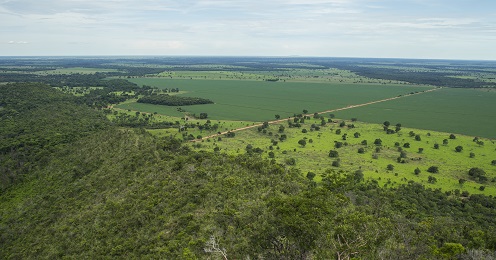New report: The vast majority of Danish soya imports threaten rainforests
A new report from the University of Copenhagen demonstrates that conventionally grown soya accounts for 71% of Danish soya imports. This means that the vast majority of Danish soya imports come from South America, where producers clear rainforest to expand agricultural land, with significant consequences for biodiversity and CO2 emissions.

Despite an increased awareness that soya ought to be sourced from producers who don’t contribute to deforestation, conventionally grown soya-beans continue to account for the lion’s share of Danish soya imports.
A new report from the University of Copenhagen’s Department of Food and Resource Economics maps Danish soya imports to examine the proportion of soya producers who can guarantee that their exports do not come from areas of cleared forest.
The conclusion is that 71% of Danish soya imports come from conventional producers, whereas 20% of soya is certified through RTRS (Round Table on Responsible Soy) credits. The remaining 9% of imports meet European feed industry procurement guidelines for soya.
"Unlike foods such as coffee and cocoa, where consumer demand has driven sustainable production, and palm oil, where food companies and retailers have helped promote responsible production, we have only recently begun to see the same real interest and demand for responsible soya," remarks Associate Professor Aske Skovmand Bosselmann, one of the report’s authors.
Credits do not guarantee deforestation-free production
RTRS credits that cover 20% of imports, the equivalent of 300,000 tonnes of soya, are not a guarantee against deforestation. In practice, they can come from the conventional supply chain, where there is no way of guaranteeing soya provenance. The purpose of the credits is to ensure that a matching amount of soya-bean is grown responsibly, without the need for deforestation.
According to Aske Skovmand Bosselmann, this means that although a certain amount of soya is certified with credits, almost all South American soya-bean exports are conventionally grown and cannot be guaranteed to be deforestation-free. The lack of traceability means that it is difficult to guarantee that soya doesn’t come from production where important biomes have been converted into soya fields – despite being offset by credits.
Fails to resolve a global issue
Previous calculations estimate that it would cost Danish industry roughly DKK 28 million kroner ($4.1 million) a year to purchase RTRS credits for the 1.7 million tonnes of annual soya imports to Denmark.
"Taken within context, this sum is relatively small. It amounts to an increase of roughly $2.50 per tonne of soya-bean, an amount that doesn’t exceed the month-to-month price fluctuations experienced by soya importers," explains Aske Skovmand Bosselmann.
However, neither certifications via credits, nor directly guaranteed deforestation-free soya solve the problem of deforestation. Regardless of where soya comes from, it is impossible to satisfy the increasing demand for it without impacting forested areas.
"Global demand for soya protein must decrease significantly if we want to avoid further deforestation. Regardless of whether we or another country imports the tons of soya that cause deforestation, the issue is global," he says.
Therefore, Bosselmann proposes that major soya feed purchasers look for alternative protein sources. In the long term, these may include processed grasses and broad beans (fava beans).
Related News
Contact
Aske Skovmand Bosselmann
Associate Professor
Department of Resource and Food Economics
ab@ifro.ku.dk
+45 35 33 68 89
Nanna Birk
Press officer
nbj@science.ku.dk
+45 93 51 60 02
Facts
- Among its many applications, soy is used for protein in feed for livestock production. Denmark and Europe import large amounts of these protein-rich beans from Brazil, Argentina, Paraguay and Bolivia – including from natural areas in the Amazon, Cerrado and Gran Chaco, where nature is cleared to make way for agricultural cultivation.
- It is estimated that deforestation in the tropics alone accounts for 20 percent of global greenhouse gas emissions, and that globally, it is to blame for nearly a third of anthropogenic greenhouse gas emissions.
- When a forest is cleared, the soil’s ability to bind carbon is reduced. Furthermore, deforestation threatens biodiversity as plant and animal habitats are destroyed.
- Denmark imported approximately1.8 million tons of soya in 2014, of which 1,7 million tons were soya-beans, making it the sixth largest soya-bean importer in Europe. Danish imports account for 600,000 hectares of land in South America, the equivalent of twice the island Funen's area (or slightly less than all of Zealand).
- It is estimated that the proportion of Danish imported soya which meets production requirements that at a minimum adhere to FEFACS’ (European Feed Manufacturers’ Federation) Soy Sourcing guidelines, accounts for approximately 29 %. This consists primarily (approx. 20%) of RTRS credits purchased by Danish companies, i.e., credits, not physically certified soy.
- Between August 2018 and July 2019, deforestation is estimated to have cost over a million hectares in the Amazon alone, the highest level since 2010 (ibid).
